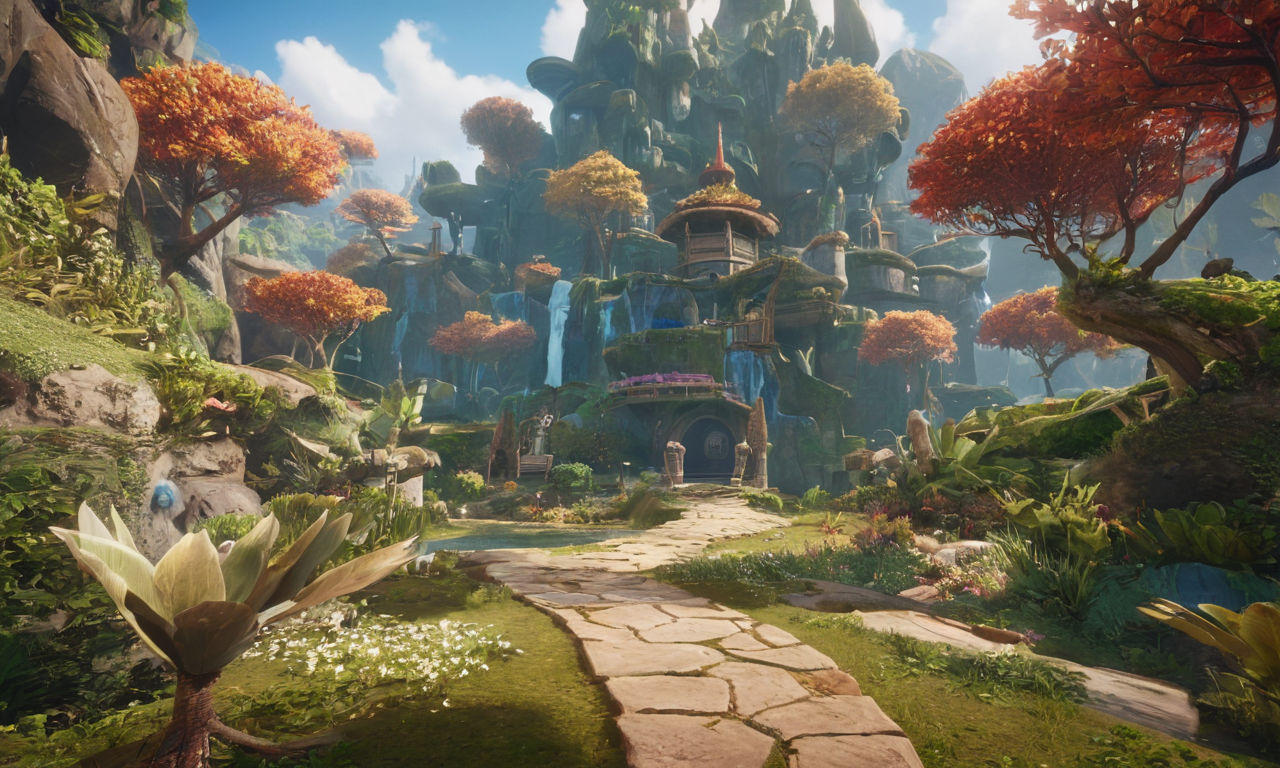Introduction
Game world design plays a crucial role in captivating players and enhancing their overall gaming experience. A well-designed game world can immerse players in a virtual environment, making them feel like an integral part of the game. By focusing on elements such as narrative integration, environmental detailing, and interactive features, game designers can create engaging and memorable worlds that keep players coming back for more.
Understanding Game World Design
Game world design refers to the process of creating and shaping the virtual environments where gameplay takes place. This design aspect encompasses various elements, including visuals, sound, mechanics, and storytelling. A well-crafted game world can significantly impact player immersion, interaction, and overall enjoyment of the game.
Captivating game environments are essential for player retention and enjoyment. When players feel connected to the virtual world they are exploring, they are more likely to become emotionally invested in the game. This emotional attachment can lead to increased playtime, word-of-mouth recommendations, and a loyal player base.
Key Elements of Game World Design
Narrative Integration
Narrative integration involves seamlessly blending storytelling elements into the game world. By incorporating a compelling narrative that unfolds as players progress through the game, designers can create a sense of purpose and progression. This integration can enhance player engagement by giving them a reason to explore the world and uncover its secrets.
Environmental Detailing
Visuals play a significant role in creating immersive game worlds. Environmental detailing focuses on designing visually appealing and detailed environments that draw players in and stimulate their senses. From lush forests to futuristic cities, each detail matters in making the game world feel vibrant and alive.
Interactive Features

Interactive features are essential for keeping players engaged with the game world. By providing opportunities for interaction, such as puzzles, hidden secrets, or dynamic elements, designers can encourage exploration and experimentation. These interactive elements not only enhance player engagement but also add depth to the game world, making it more interactive and dynamic.
In conclusion, understanding the importance of game world design and focusing on key elements such as narrative integration, environmental detailing, and interactive features can help designers create captivating and immersive game worlds. By prioritizing player engagement and storytelling, game designers can craft environments that leave a lasting impact on players and keep them coming back for more adventures.
Step 1: Crafting a Compelling Narrative
Crafting a compelling narrative is crucial in capturing players' attention and enhancing their overall gaming experience. A strong narrative can drive player engagement, make the game world more immersive, and create emotional connections with the players. Here are some key points to consider when integrating storytelling elements into the game world effectively:
Engaging Characters: Create well-developed and memorable characters that players can relate to. Developing characters with depth and personality can enrich the narrative and make the game world feel more alive.
Plot Development: Build a cohesive and engaging storyline that unfolds gradually as players progress through the game. Incorporate plot twists, character arcs, and meaningful choices to keep players invested in the narrative.
Worldbuilding: Pay attention to worldbuilding details such as lore, history, cultures, and environments. A richly detailed game world can immerse players in the story and create a sense of depth and realism.
Interactive Dialogue: Include interactive dialogue options that allow players to shape the story based on their choices. Branching dialogues can provide a personalized gameplay experience and make players feel more involved in the narrative.
By focusing on these aspects, game developers can create a compelling narrative that resonates with players and adds depth to the game world.
Step 2: Developing Immersive Environments
Creating immersive environments is essential for drawing players into the game world and enhancing their overall gaming experience. Immersive environments stimulate the player's senses, spark curiosity, and encourage exploration. Here are some techniques for developing visually stunning game environments:
Realism vs. Fantasy: Decide on the aesthetic direction of the game world, whether it leans towards realistic settings or fantastical realms. Consistent art style and attention to detail can enhance the visual appeal of the environment.
Environmental Storytelling: Use environmental cues, such as architecture, weather effects, and ambient sounds, to convey storytelling elements without explicit exposition. Subtle details can evoke emotions and immerse players in the game world.
Dynamic Lighting and Weather Effects: Implement dynamic lighting and weather systems to create a living, breathing world that changes with the passage of time. Day-night cycles, weather patterns, and seasonal effects can add depth to the environment.
Interactive Elements: Incorporate interactive elements within the environment that respond to player actions. Interactive scenery, destructible objects, and hidden pathways can make the game world feel dynamic and engaging.
By applying these design elements, developers can create immersive environments that captivate players and make the game world a central element of the gaming experience.
Step 3: Implementing Interactive Features

Interactive features play a vital role in keeping players engaged, fostering player agency, and enhancing the overall gameplay experience. These features provide opportunities for players to interact with the game world, make choices, and influence the outcome of the game. Here are some key points to consider when implementing interactive features:
Player Agency: Allow players to make meaningful decisions that impact the game world, characters, or storyline. Giving players agency promotes engagement and empowers them to shape their own gaming experience.
Puzzles and Challenges: Integrate puzzles, challenges, and interactive gameplay mechanics that require problem-solving skills and critical thinking. Well-designed puzzles can keep players stimulated and provide rewarding gameplay experiences.
Exploration Rewards: Reward exploration by hiding secrets, collectibles, and Easter eggs throughout the game world. Encouraging players to explore every corner of the environment can lead to discovery and a sense of accomplishment.
Multiplayer Interactions: Implement multiplayer interactions that enable players to collaborate, compete, or communicate with each other within the game world. Social interactions can enhance the community aspect of gaming and foster player engagement.
By incorporating interactive features that cater to player preferences and gameplay styles, developers can create a dynamic and engaging gaming experience that keeps players coming back for more.
Step 4: Enhancing Player Engagement
In the realm of game design, player engagement stands as a pivotal metric for success. Engaging game worlds can captivate players, keeping them immersed for hours on end. Here are some strategies to enhance player engagement through dynamic game world design:
Leveraging Immersive Storytelling
Integrating compelling narratives within the game world can deeply immerse players in the gameplay experience. By weaving intricate storylines and character arcs into the environment, designers can create a sense of purpose and emotional investment for players.
Interactive Elements and Mechanics
Incorporating interactive features such as hidden easter eggs, dynamic environmental changes, and responsive NPCs can add layers of engagement to the game world. Players appreciate when their interactions have meaningful consequences within the game universe.
Creating Engaging Challenges
Designing challenging quests, puzzles, or combat scenarios that align with the game world's narrative can inspire players to explore and interact more deeply with the environment. Engaging challenges keep players on their toes, fostering a sense of accomplishment upon completion.

Leveraging Feedback and Data
Continuous monitoring of player behavior and feedback is crucial for refining and enhancing player engagement. Analyzing player data, such as playtime patterns, preferred activities, and areas of interest, can inform future design decisions to tailor the game world to the players' preferences.
Step 5: Fostering Replay Value
Fostering replay value in game worlds is essential for ensuring prolonged player interest and satisfaction. By creating game worlds that encourage players to revisit and explore, designers can enhance the overall gaming experience. Here are some design tips for adding layers of complexity and discovery to the game environment:
Dynamic World Events
Implementing dynamic events that unfold based on player actions or time triggers can add unpredictability and freshness to the game world. By introducing periodic events, seasonal changes, or evolving storylines, designers can entice players to return to witness new developments.
Hidden Secrets and Collectibles
Incorporating hidden secrets, rare collectibles, or alternate story paths can motivate players to explore every nook and cranny of the game world. Discovering these hidden gems offers a sense of achievement and incentivizes replayability as players strive to uncover all the mysteries the world holds.
New Game Plus Features
Introducing a New Game Plus mode, where players can restart the game with their acquired skills or items intact, provides a fresh challenge and encourages multiple playthroughs. By offering additional gameplay incentives or challenges in subsequent playthroughs, designers can enhance the replay value of the game world.
Player-Driven Choices and Consequences
Allowing players to make meaningful decisions that impact the game world's narrative or ecosystem can create branching storylines and divergent outcomes. Players are more likely to replay the game to explore different choices and experience the consequences of their decisions, adding depth and replay value to the game world.
Conclusion
In conclusion, designing an engaging game world entails a meticulous blend of storytelling, interactive elements, challenges, and replay value. By following the five essential steps outlined in this guide, game designers can craft immersive and dynamic game environments that captivate players and enhance their gaming experience. Remember, a well-crafted game world not only enhances player engagement but also fosters long-term player retention and loyalty, ensuring a memorable gaming experience for all who venture into the virtual realms.



